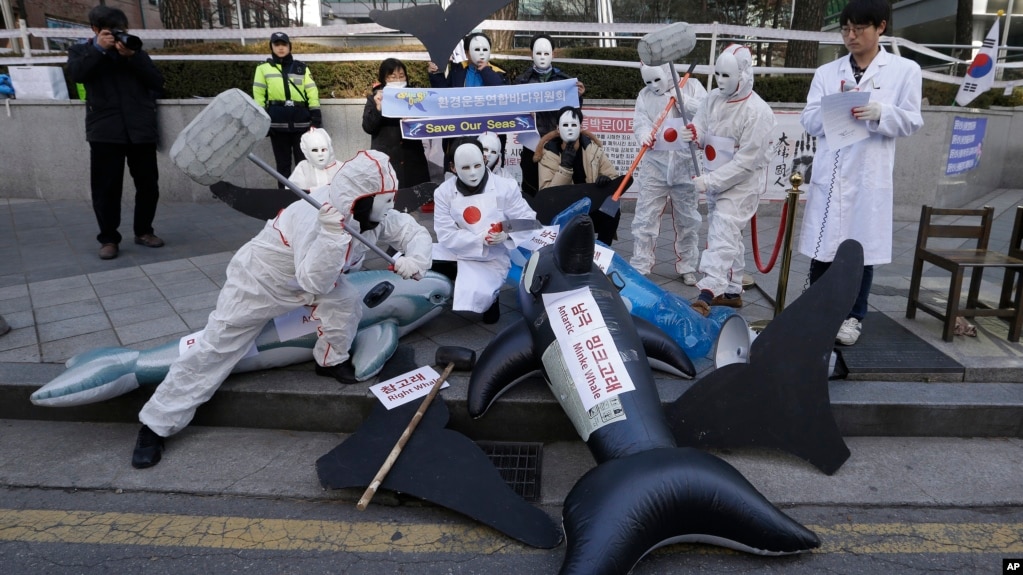Superlative
Senior Member
- Mar 13, 2007
- 1,382
- 109
- 48
Japan whaling ship returns with 500 whales, shrouded in questions
The Associated Press
Published: March 22, 2007
TOKYO: A Japanese whaling ship that triggered a high-seas showdown with environmental groups and suffered a deadly fire returned to port Friday with a catch of 508 whales, despite having to cut its annual hunt short after the accident.
The homecoming, however, was dogged with questions, as authorities prepared to investigate the below-deck blaze that killed a sailor and crippled the ship as well as the anti-whaling protests that had earlier tried to block the hunt.
Journalists were being barred from the Tokyo wharf where the processing ship Nisshin Maru docked with its crew of 149. Japan's Fisheries said it would hold a news conference only next week after the investigation has progressed.
The black-and-red hulled ship, with the word "RESEARCH" emblazoned just above the waterline, slipped into port flanked by about 10 patrol boats for security, but there was no immediate sign of protests in the area.
Greenpeace issued a fresh condemnation of Japan's whaling program on Friday, calling for the damaged ship to be retired. It criticized Japan's whaling, ostensibly done for research purposes, as not yielding useful data on the marine mammals.
The Nissin Maru's return brings an early end this year's hunt in the icy waters off Antarctica, which had been scheduled to continue through the end of March. It was the first time in 20 years that Japan had to abort its whaling mission.
Still, the six-vessel fleet managed to kill 508 whales out of a target of 860. After scientific research is conducted on the animals, the meat will be sold to market where it is snapped up as a culinary delicacy by the Japanese.
The fire aboard the Nisshin Maru broke out last month, killing one crew member and leaving the ship unable to sail under its own power for 10 days.
The accident prompted strong protests from the New Zealand government and from the environmental group Greenpeace over potential oil and chemical spills.
The fleet had been earlier harried by protests by the group Sea Shepherd.
Japanese video depicted protesters aboard a Sea Shepherd ship — flying a skull-and-crossbones pirate flag — launching smoke canisters, throwing containers filled with chemicals, and dropping ropes and nets to entangle the Japanese ships' propellors.
The Nisshin Maru was eventually repaired and able to return to Japan.
It is the second ship in the fleet to come home. Three more spotter ships are scheduled to return Saturday and the final vessel on Sunday.
Japan's fleet is part of a scientific whaling program that Tokyo says provides crucial data for the International Whaling Commission on populations, feeding habits and distribution of the mammals in the seas near Antarctica.
The hunts are allowed by the International Whaling Commission, but environmental groups have long condemned the hunts as a pretext for keeping commercial whaling alive after the practice was banned by the IWC in 1986.
http://www.iht.com/articles/ap/2007/03/23/asia/AS-GEN-Japan-Whaling-Ship.php
The Associated Press
Published: March 22, 2007
TOKYO: A Japanese whaling ship that triggered a high-seas showdown with environmental groups and suffered a deadly fire returned to port Friday with a catch of 508 whales, despite having to cut its annual hunt short after the accident.
The homecoming, however, was dogged with questions, as authorities prepared to investigate the below-deck blaze that killed a sailor and crippled the ship as well as the anti-whaling protests that had earlier tried to block the hunt.
Journalists were being barred from the Tokyo wharf where the processing ship Nisshin Maru docked with its crew of 149. Japan's Fisheries said it would hold a news conference only next week after the investigation has progressed.
The black-and-red hulled ship, with the word "RESEARCH" emblazoned just above the waterline, slipped into port flanked by about 10 patrol boats for security, but there was no immediate sign of protests in the area.
Greenpeace issued a fresh condemnation of Japan's whaling program on Friday, calling for the damaged ship to be retired. It criticized Japan's whaling, ostensibly done for research purposes, as not yielding useful data on the marine mammals.
The Nissin Maru's return brings an early end this year's hunt in the icy waters off Antarctica, which had been scheduled to continue through the end of March. It was the first time in 20 years that Japan had to abort its whaling mission.
Still, the six-vessel fleet managed to kill 508 whales out of a target of 860. After scientific research is conducted on the animals, the meat will be sold to market where it is snapped up as a culinary delicacy by the Japanese.
The fire aboard the Nisshin Maru broke out last month, killing one crew member and leaving the ship unable to sail under its own power for 10 days.
The accident prompted strong protests from the New Zealand government and from the environmental group Greenpeace over potential oil and chemical spills.
The fleet had been earlier harried by protests by the group Sea Shepherd.
Japanese video depicted protesters aboard a Sea Shepherd ship — flying a skull-and-crossbones pirate flag — launching smoke canisters, throwing containers filled with chemicals, and dropping ropes and nets to entangle the Japanese ships' propellors.
The Nisshin Maru was eventually repaired and able to return to Japan.
It is the second ship in the fleet to come home. Three more spotter ships are scheduled to return Saturday and the final vessel on Sunday.
Japan's fleet is part of a scientific whaling program that Tokyo says provides crucial data for the International Whaling Commission on populations, feeding habits and distribution of the mammals in the seas near Antarctica.
The hunts are allowed by the International Whaling Commission, but environmental groups have long condemned the hunts as a pretext for keeping commercial whaling alive after the practice was banned by the IWC in 1986.
http://www.iht.com/articles/ap/2007/03/23/asia/AS-GEN-Japan-Whaling-Ship.php



